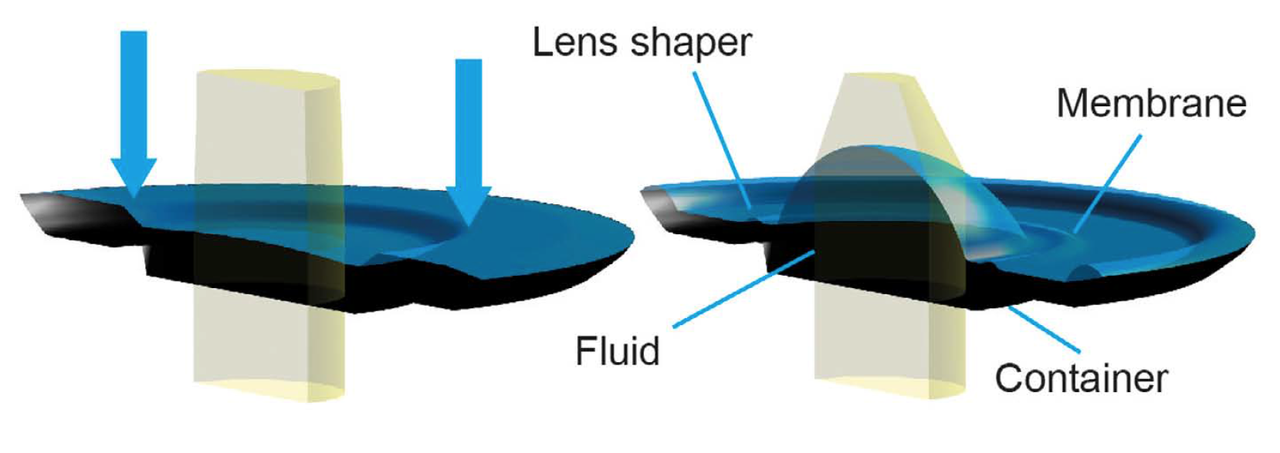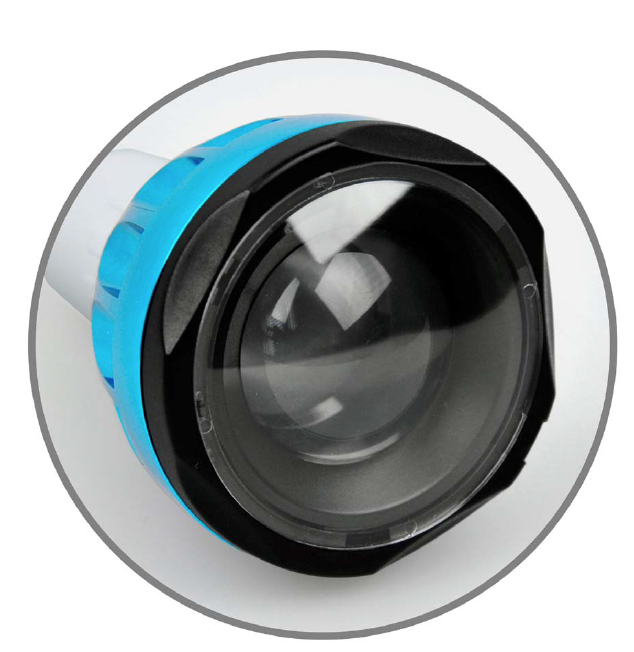Focus Tunable Lenses for LED Lighting by Optotune AG
Focus tunable lenses open up new possibilities in the design of LED based luminaires. With these shape changing lenses, the beam angle of a spotlight can be flexibly adjusted while keeping the efficiency on a constant, high level. Compact solutions combining a floodlight and a spotlight in one product can therefore be realized. This innovative technology reduces complexity and offers more flexibility in lighting design, especially for changing environments like museums, and shops. Joerg Wertli from Optotune AG demonstrates a very interesting technology for these applications.
For the design of a spotlight, there are components available for a great variety of different beam angles. As they are fixed, the customer has to decide in the design phase which angles to use for an installation. In some cases, it’s possible to exchange optics for different beam angles. However, this is time consuming and cumbersome, especially as lamps are often hard to access after installation. Traditional solutions which are available to vary the beam angle without exchanging components usually exhibit a decreased efficiency and can be complex. One approach is to shift a lens away from an LED to focus the beam (up to a certain point). However, rings and shadows typically appear in the spot and with increasing distance from the LED, a lot of light is lost. On the other hand, large show lights or even some museum lights are equipped with a zoom lens for the adjustment of the spot size. While requiring lots of space and not being efficient, such a zoom lens is expensive in development and manufacturing, making it unsuitable for mass lighting applications. In contrast, a tunable lens allows the beam angle to be set on site and adjusted whenever necessary to the desired value. There is also the possibility of motorizing the tuning process for remote controlled adjustments. Having just one product from flood to spot lowers complexity and costs. Furthermore, a tunable lens offers new opportunities with varying beam angles for different settings, like in a museum with changing exhibits.
Working Principle of Focus Tunable Lenses
The manually tunable lenses for LED lighting from Optotune are shape-changing lenses. The core of the lens consists of a container, which is filled with an optical fluid and sealed off with an elastic polymer membrane. Through an inclination in the housing, this container is pressed against a ring or so-called “lens shaper”. This causes a rise in liquid pressure in the container and hence, a spherical lens to form. This changes the focal length to shorter values (figure 1). The clear aperture as well as the position of the lens shaper remains constant throughout the whole tuning range. Therefore, no efficiency is lost when tuning from the wide flood angle to the small spot. This technology is both very efficient and compact and allows a flexible adjustment of the beam angle when implemented in a spot light. Turning a ring controls the movement of the lens shaper into the liquid filled container and therefore the shape of the lens. The liquid used for these lenses is polymer based, highly transmissible from the UV up to the near infrared range of up to 2500 nm. Furthermore, the material is UV stable. It can even be used for applications constantly operating in the UV range, all the way down to a wavelength of 250 nm. In addition, the polymer material has a high abbe number, providing excellent color quality in the spot with minimal chromatic aberrations.
 Figure 1: Working principle of a tunable lens
Figure 1: Working principle of a tunable lens
Optics Design - in General
In figure 2, a spotlight design using Optotune’s ML-25-50 Lumilens is shown, illustrating the compact design possibilities for a spotlight. When designing a spotlight with a tunable lens, the optical design is outlined as shown in figure 3. The LED and the secondary optics define the maximum beam angle. The tunable lens is then used to focus the beam from the wide flood angle to a small spot. When laying out the optics design for a fixture with a tunable lens, the resulting tuning range largely depends on the light emission characteristics of the LED and the secondary optics. Combinations of LEDs and secondary optics with a beam angle of 40° and above have shown the best results, achieving ranges down to narrow spot angles of below 10° in some cases. In order to achieve the best possible tuning result, the tunable lens has to be placed with a distance to the secondary optics such that the whole aperture of the tunable lens is filled up. Therefore, with increasing aperture size in relation to the diameter of the secondary optics, the distance between the secondary optics and the tunable lens increases. For the exact distance, optical simulations are very useful to determine the exact layout and expected performance. Alternatively, it can also be efficient to use a practical approach with an optical setup allowing the flexible variation of the distances between the different components to determine the optimum optical design in the lab. When choosing a reflector to collimate the light before the tunable lens, a diffuser has to be implemented between the reflector and the tunable lens, to prevent an imaging of the LED chip when tuned to the small spot angle. Furthermore, the reflector should have a smooth surface or a very small structure to prevent the imaging of the reflector structure. With TIR optics, versions with frosted tops can be used to circumvent the integration of an additional diffuser. Figure 2: The application example of a GU10 replacement lamp demonstrates the compact design with the ML-25-50 Lumilens
Figure 2: The application example of a GU10 replacement lamp demonstrates the compact design with the ML-25-50 Lumilens
Optics design – Special Designs
Figure 3: Schematic view of the optical system at both ends of the zoom range
While optical designs with a wide angle of around 40°-50° provide the best results as described above, there are lighting applications requiring specifically narrow or wide angles with tunable capabilities. An example of a narrow angle design is shown in Figure 4. Using a narrow TIR lens with 24° divergence, a range down to 6° was simulated. On the other side, designs with wide angles up to 100° were evaluated with a practical approach. Using a fixed lens to collimate the LED to 100° before the tunable lens enables a range down to a 30° spot.
 Figure 4: Narrow angle optical design in a simulation
Figure 4: Narrow angle optical design in a simulation
Optics design – Zoom Systems
While most lighting situations require a diffuse spot, it is sometimes required to have a homogenously lit up spot with a specific, determined shape, e.g. a trapezoid for perspective illumination of a painting in a museum. In such cases, an intermediate mask is imaged by projection optics. The same principle applies to gobo projectors, where the mask might contain a slide of a company logo, for example. Zoom optics including several lenses is required to vary the size of such a projection. Again, focus tunable lenses can help to reduce the size and increase the efficiency of such optics. Optical designs with plano-convex lighting lenses have shown zoom factors in the range of 4 times to 16 times zoom using two tunable lenses and a set of fixed lenses. With tunable lenses, the overall system is much more compact, in general, with the size of about 50% of the one of conventional systems. Furthermore, motorization is straightforward, as no lenses have to be shifted and the tunable lenses only have to be deflected. Therefore, lighting zoom systems can be fully motorized for a fraction of the cost of conventional, mechanical systems.
Focus Tunable Lenses in LED Arrays
For large LED lighting fixtures, arrays of several LEDs are often used to increase the light output. It is possible to design a grid to hold a focus tunable lens element over each LED. A second grid with lens shapers is pressed into the liquid filled elements to form lenses. That way, it is possible to achieve a large tuning range for different LED assemblies, e.g. big circles or rectangular LED arrays. Due to some overlapping of the light fields from adjacent LEDs, there is also an additional homogenization, which is advantageous for achieving a nice, smooth spot in total.
Conclusion
In summary, it can be said that focus tunable lenses offer new possibilities for various lighting applications. Based on polymer materials, these lenses have outstanding chromatic properties and a wide transmission range. The materials exhibit a high transmission over the spectral range from the UV range up to the near infrared. The material is UV stable. The tunable lenses are highly attractive for LED lighting application requiring a variable spot size. The principle of a lens shape changing lens where the distance to the LED stays constant, allows varying the beam angle without the loss of efficiency. Besides applications with variable spotlights for museums, shops and other fixtures that light up changing environments, the focus tunable lens technology is also beneficial for compact zoom lenses, for gobo projectors or lens arrays for large LED based light panels.


